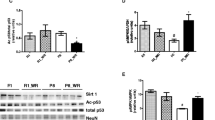Abstract
The research of the last decade highlighted the existence of a family of genes activated by cellular stresses that allow the cells to reactivate defense and repair activities regardless of age. The prolonged activation of these genes enhances the organism health and lifespan. Members of this gene family are called sirtuins (SIRT). The founding member of the SIRT protein family, Sir2 is a limiting component of yeast longevity. Many members of this family have been also identified as key longevity regulators in species ranging from yeast to fly. On the other hand, the role of SIRTs in the regulation of mammalian ageing has been questioned. While SIRTs’ effects on lifespan are still a matter of scientific debate, the beneficial effects of SIRTs in terms of physical health and quality of aging are widely accepted. Increasing evidence suggests a pivotal role for SIRTs in mediating the adaptive response to physical exercise. The following review summarizes the knowledge so far acquired on sirtuins’ role in mediating beneficial effects of physical exercise. In particular, the first paragraph gives an overture on mammalian sirtuins defining their localization, function when possible, and substrates. In the second paragraph, we discuss recent data regarding alteration of sirtuins expression and activity after physical exercise collected by our laboratory and others’.

Similar content being viewed by others
References
Morris BJ (2012) Seven sirtuins for seven deadly diseases of aging. Free Radic Biol Med
Pellegrini L, Pucci B, Villanova L, Marino ML, Marfe G, Sansone L, Vernucci E, Bellizzi D, Reali V, Fini M, Russo MA, Tafani M (2012) SIRT3 protects from hypoxia and staurosporine-mediated cell death by maintaining mitochondrial membrane potential and intracellular pH. Cell Death Differ 19(11):1815–1825
Lanza IR et al (2008) Endurance exercise as a countermeasure for aging. Diabetes 57(11):2933–2942
Hokari F, Kawasaki E, Sakai A, Koshinaka K, Sakuma K, Kawanaka K (2010) Muscle contractile activity regulates Sirt3 protein expression in rat skeletal muscles. J Appl Physiol 109(2):332–340
Gurd BJ, Perry CG, Heigenhauser GJ, Spriet LL, Bonen A (2010) High-intensity interval training increases SIRT1 activity in human skeletal muscle. Appl Physiol Nutr Metab 35(3):350–357
Cantò C et al (2010) Interdependence of AMPK and SIRT1 for metabolic adaptation to fasting and exercise in skeletal muscle. Cell Metab 11:213–219
Koltai E, Szabo Z, Atalay M, Boldogh I, Naito H, Goto S, Nyakas C, Radak Z (2010) Exercise alters SIRT1, SIRT6, NAD and NAMPT levels in skeletal muscle of aged rats. Mech Ageing Dev 131(1):21–28
Costford SR et al (2010) Skeletal muscle NAMPT is induced by exercise in humans. Am J Physiol Endocrinol Metab 298(1):117–126
Marfe G, Tafani M, Pucci B, Di Stefano C, Indelicato M, Andreoli A, Russo MA, Sinibaldi-Salimei P, Manzi V (2010) The effect of marathon on mRNA expression of anti-apoptotic and pro-apoptotic proteins and sirtuins family in male recreational long-distance runners. BMC Physiol 12(10):7
Guerra B et al (2010) SIRT1, AMP-activated protein kinase phosphorylation and downstream kinases in response to a single bout of sprint exercise: influence of glucose ingestion. Eur J Appl Physiol 109:731–743
Author information
Authors and Affiliations
Corresponding author
Rights and permissions
About this article
Cite this article
Pucci, B., Villanova, L., Sansone, L. et al. Sirtuins: the molecular basis of beneficial effects of physical activity. Intern Emerg Med 8 (Suppl 1), 23–25 (2013). https://doi.org/10.1007/s11739-013-0920-3
Published:
Issue Date:
DOI: https://doi.org/10.1007/s11739-013-0920-3




